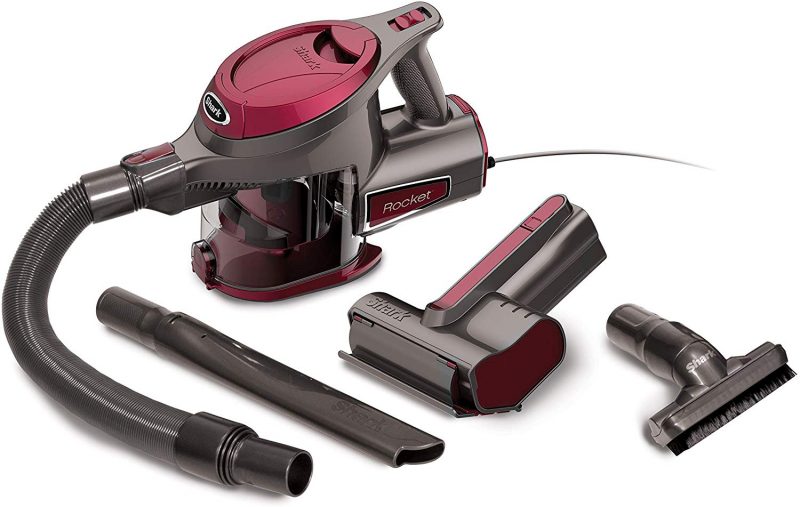Although vacuum cleaner maintenance are not nearly as costly as car repairs, handheld vacuums, just like cars, provide clues when maintenance is required or past due.
I rode along with my daughter this morning to get an oil change. The mechanic informed her that her rear brakes were on their last leg. He asked, “have you heard squeaking or squealing when applying the brakes?”. In typical teenager fashion, she responded “no”. I stepped in at that point and explained that the “odd” sound when she was backing out the garage was an indication that her brakes were going bad. A lightbulb went off in her head. Although vacuum cleaner maintenance are not nearly as costly as car repairs, handheld vacuums, just like cars, provide clues when maintenance is required or past due.
Is your handheld vacuum cleaner losing suction? Battery life depleted? Has the motorized bristle bar stopped spinning?
If you answered “yes” to any of these questions, it is time to perform some basic maintenance on your handheld vacuum. Vacuum cleaner maintenance can keep it running like brand new.
Maintenance…the Right Way
Once upon a time, a “friend” cleaned their dustbowl but didn’t allow it to dry before reassembling the handheld vacuum cleaner. The result? Water from the dustbowl dripped into the motor rendering it useless. “My friend” had to purchase a new handheld vacuum.
This is a safe space so I will admit that I was that person. I was impatient and didn’t follow the simple instructions to care for handheld vacuum. Don’t be “my friend”.
Follow these simple instructions to properly care for your handheld vacuum cleaner.
How to Clean and Care for your Handheld Vacuum Cleaner
These instructions are general guidelines. Refer to the manufacturer’s website or handbook for specific information regarding your handheld vacuum.
Empty the Dust Bowl
This may feel obvious, but it isn’t. If a dust bowl is too full, the filter and motor will not receive enough air to properly function and can result in a burnt motor. You may experience a reduction or loss of suction if the dust bowl is too full.
Most dust bowls contain a “max fill” line. It is possible to fill a dust bowl before the battery dies. When vacuuming, periodically glance to see if you are approaching the max fill line.
As a general rule of thumb, I recommend emptying the dust bowl after each use. Creating this habit will reduce the odds that you are operating with a full dustbowl.
Wash the Dust Bowl
When handheld vacuum clean suction power has diminished, step one in maintenance triage is to wash the dust bowl. The dust bowl should also be washed if you see dirt and dust caked on the sides.
Furthermore, only the dust bowl should be in contact with water. Do not attempt to rinse out a dustbowl while the handheld vacuum is fully assembled.
It is vitally important that the dust bowl be completely dry before reassembling the handheld vacuum. The strong suction of the vacuum will attract any water straight into the filter and motor causing fatal damage. Remember the story about “my friend”?
Clean the Vacuum Filter
Maintenance triage step two for loss of suction is to clean the filter. Most, but not all, handheld vacuum cleaners include filters that can be rinsed and reused.
Wash reusable vacuum filters in warm water and let air dry for 24 hours. Note: Some manufacturers specifically say NOT to use soap when cleaning the filter. Accordion-style filter with caked-on dust can be scrubbed with the brush attachment to loosen dirt. For the same reason that a dustbowl must be completely dry, so must the filter.
How often should the filter be cleaned? Black + Decker recommends “as needed” while Dyson recommends cleaning the filter every three months. Shark suggests cleaning pre-motor filters monthly and post-motor filters annually (filter types vary by model).
Replace the Vacuum Filter
Not all handheld vacuum cleaner filters need to be replaced. Take note of the manufacturer suggestions.
Black + Decker DustBuster CHV1410L contains a washable filter, but the manufacturer still recommends replacement every six to nine months. Shark advertises the Rocket Ultra-Light HV292 as having “zero maintenance costs” with its completely reusable filters.
Clean the Rotary Brush
Rotary bristle brush attachments on handheld vacuum cleaners are a user favorite because the motorized brush loosens dirt and hair. When the bristles are coated and entwined with debris, the tool is unable to effectively function. Consequently, tangled bristles also allow debris to get caught and stuck inside the attachment.
My favorite part of handheld vacuum cleaner maintenance is cleaning the rotary bristle brush (my second favorite thing is emptying a full dust bowl). I find it truly satisfying to remove all the strings, hair, and pet fur caught in the bristles and restoring life to my handheld vacuum.
Once a month, if not sooner, I use my fingers to loosen and remove the tangled mess of hair, pet and human, from the bristles. Stubborn messes can be removed by cutting with household scissors.
In depth cleaning of the rotary beater brush attachment varies by model; some pop out and others require a screwdriver to remove.
Battery or Charger Problem
Newer cordless handheld vacuum cleaners are made with lithium ion batteries that retain battery life, even when constantly connected to the docking station. Older handheld vacuum cleaners that used nickel metal hydride advised running a battery dead, fully charging, and then disconnecting from the charging source.
Black + Decker’s Support Page suggests a system test to determine if a battery or charger needs to be replaced. The test is quite universal and would be applicable to all handheld vacuum brands.
First, connect the handheld vacuum cleaner to the charger/docking station. After waiting 30 minutes, touch the charger to feel for warmth. If the charger is warm, it is working and the battery is the culprit. Conversely, if the charger is still cool, it is not processing an electric current and needs to be replaced.
Responsible Vacuum cleaner maintenance
Owning a car demands responsible proper maintenance to protect your investment. Likewise, maintenance is required for a handheld vacuum cleaner and all household appliances. Fortunately, handheld vacuum cleaners require simple, inexpensive care.






Leave a Reply